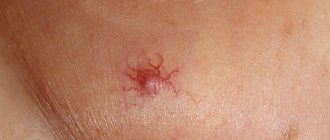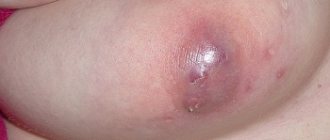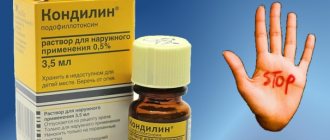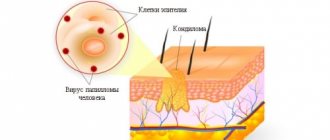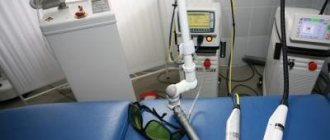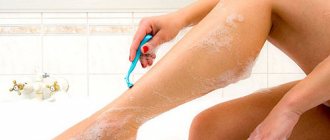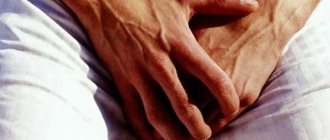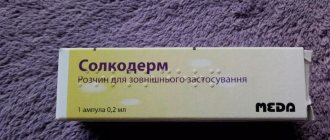Hello dear readers. Women's breasts require attention throughout their lives. From the period of girlhood to old age, we notice, albeit small, but still changes occurring in our bust. Sometimes they are physiological: growth, enlargement of the mammary gland during pregnancy, tissue involution after 40 years. And sometimes they are suspicious or dangerous. Today we will talk about what white dots on the nipples are, what causes this phenomenon and whether you should be wary of it.
But what about men, a thoughtful reader will ask, does gender protect against the appearance of various tubercles, pimples or white spots in the nipple area in representatives of the stronger sex; they are not pregnant and do not breastfeed. No, this phenomenon occurs in men too. And we'll tell you why.
What about teenagers? In a teenager, the appearance of such formations is not uncommon; if they are squeezed out, this is acne caused by the perturbations of puberty. Read about other reasons below.
When can bumps appear?
A small lump in the breast can appear for natural reasons related to hormonal processes in the body, before, during, or at the end of menstruation. If, month after month, lumps appear during these periods without causing pain or discomfort and are not accompanied by discharge from the nipples, then there is nothing to worry about. However, when visiting a doctor, this should definitely be mentioned.
There are a number of other cases when a lump in the chest can become the main symptom of a serious illness that requires urgent treatment. If a lump appears inside the mammary gland (in the tissues), on the chest (under the skin), near the nipple or on the nipple itself, you should immediately consult a specialist. You should also pay attention to the lumps that appear in the armpits, because this area is connected to the breasts by lymph nodes.
What to do if you feel a lump in your chest
When a lump begins to be felt in the mammary gland, you need to consult a mammologist. Before going to a specialist, it is important to pay attention to your general health: temperature, whether the lump hurts, whether there is discharge from the nipples, where exactly the lump is felt. All these factors will help the doctor create a clearer picture that is understandable for diagnosis.
Features of occurrence during pregnancy
During pregnancy, a woman is especially susceptible to various diseases. This is due to weakened immune defenses. This process is normal during pregnancy and is necessary for a full gestation period. If the body does not weaken its defenses, the immune system may perceive the fetus as a foreign organism that needs to be gotten rid of.
Against the background of reduced protective activity, infectious diseases are often activated in the body of the expectant mother. In addition to natural processes, the appearance of warts during pregnancy is influenced by a lack of vitamins, an increase in body weight, and friction of the skin against tight clothing.
We recommend reading:
- Causes of condylomas in intimate places
- How to treat Fordyce granules
- What is the danger of flat condylomas
The main problem in this case is that a pregnant woman is contraindicated to take drugs to fight the virus. Treatment is carried out by strengthening the immune system by adjusting nutrition.
A pregnant woman is advised to eat well. The diet should contain foods rich in vitamins and microelements. It is important to avoid stressful situations, get proper rest and lead a moderately active life.
After the birth of the child, condylomas disappear on their own. But this happens extremely rarely. You should not rely on a “happy coincidence” and ignore breast growths.
Possible diseases
The formation of a lump in the mammary gland is accompanied by several diseases:
Fibrocystic mastopathy
This is one of the forms of mastopathy common among nursing mothers. The cause of the appearance of lumps is the excessive growth of certain areas of the mammary gland. Because of this, cavities appear - cysts, and various nodes in the lump. These processes affect both breasts; among the symptoms there is also pain, the strength of which varies during the menstrual cycle. Lumps may appear in the armpits. The difference is the benign nature of these seals. This type of mastopathy has never turned into cancer. But this does not mean at all that it does not need to be treated. Sometimes it is necessary to remove (remove) formed nodes.
Benign tumor
A small lump may well turn out to be a single benign formation in the mammary gland. These neoplasms are divided among themselves according to histological characteristics:
- Fibroadenoma
- Papilloma (intraductal)
- Lipoma
- Cyst
Such tumors can form under the influence of mastopathy, but they can also appear independently, and not as a consequence of the disease.
Abscess
It appears rarely and only in women during breastfeeding. This disease implies the presence of an area with purulent melting. An abscess is a consequence of mastitis, if left untreated. Simply put, it is inflammation of the mammary gland. Mastitis occurs when harmful bacteria enter the breast ducts, as well as when milk stagnates. An abscess looks like a hard lump that causes severe pain. An abscess is such if there are additional symptoms:
- Increase in general body temperature.
- Change in breast shape as a result of tissue swelling.
- Enlarged lymph nodes under the arm.
- General weakness and malaise similar to a cold.
Mammary cancer
This is the most dangerous disease, the harbinger of which may be the appearance of a lump. The whole danger of cancer lies in the fact that it does not show any symptoms for a long time. Often it can only be detected in the final stages. The cancerous tumor is very dense in its formation, and at the same time has a strong fusion with the surrounding tissue.
Does the test detect ectopic pregnancy?
Unfortunately, life does not always go according to the written script. Sometimes those who are looking forward to a baby hear a terrible diagnosis - “ectopic pregnancy”. Many perceive it as a death sentence and the destruction of all hopes. An ectopic pregnancy is surgery, recovery and contraception for six months, and a depressed state. But even more terrible is death, the threat of which hangs over a woman who does not go to the hospital in a timely manner. Does the test detect ectopic pregnancy? What signs indicate the presence of pathology?
The appearance of formations on and around the nipple
Lumps can appear not only in the mammary glands themselves, but also on the nipples, around the nipple and near the nipple. Most often, the appearance of seals near the nipple area is a benign formation. Small compactions, white in color, are the consequences of the accumulation of secretion. When the duct is blocked, the secretion accumulates in the glands. This problem is only aesthetic in nature. This is not dangerous to health and goes away on its own over time. Therefore, if a white bump appears on the nipple, small in size, without pain, there is no reason to worry.
Sometimes such a growth can be a symptom of malignant processes. The appearance of warts, or as they are also called papillomas, is a consequence of a common disease called the human papillomavirus. There is only one treatment for it - surgical removal.
When a lump appears in the mammary gland, of all the questions, only one remains: “what could it be?” Don't immediately think about breast cancer. The appearance of lumps in the breast can be caused by completely natural processes in the body. In addition, they may turn out to be benign formations that do not cause harm to health. At the same time, it is worth monitoring your well-being and general condition more closely. If these seals do not cause any discomfort or pain, there is nothing particularly to worry about. However, it will not be superfluous to visit a doctor and consult.
Often, women notice the appearance of spots on the usually dark areola around the nipple. Uncertainty about the origin of spots on the nipples and areola raises health concerns. However, if white spots appear, they rarely indicate the occurrence of malignant neoplasms.
Types of neoplasms in the mammary gland
Duct obstruction is a consequence of blockage of the milk duct. Most often, blockage of the nipple duct occurs when breastfeeding a baby. There are also frequent cases of pathological narrowing of the canal.
Causes
Obstruction of the milk canal occurs:
- At the end of pregnancy, a pregnant woman begins to produce colostrum; if the ducts do not have time to form, the colostrum stops in the ducts, forming their obstruction.
- For a mother breastfeeding her baby:
- in the absence of regular feeding;
- Hind milk, which is richer in fat, can clog the duct;
- the baby spends little time at the mother’s breast;
- if the mother feeds the baby in the same position;
- incorrect grip of the nipple by the baby;
- uncomfortable position of the child during feeding when the duct is clamped;
- sleep in a prone position.
- If a woman finishing breastfeeding deliberately squeezes her breasts with a tight bandage or uncomfortable clothing.
Treatment
At first, spots on the nipples may not cause the woman any particular inconvenience; she does not feel any discomfort or pain. Sometimes the white dot on the nipple during breastfeeding disappears on its own when the baby intensively sucks on the breast.
If the spots form again, the white nipples become very sensitive and this makes mom uncomfortable. Bacteria multiply and infectious processes develop in the mammary glands.
Several recommendations for getting rid of a white spot on the nipple during breastfeeding:
- try to change the baby’s position when feeding, this position should ensure the baby’s correct grasp of the nipple (on all sides);
- There is no need to immediately stop breastfeeding if the nipples turn white or white spots appear around the nipple;
- apply a damp, warm cloth to the nipples, this helps soften the milk plug;
- for the same purpose, take a warm shower before each feeding of the baby;
- Lubricating the nipples with vegetable oil helps soften the milk plug very well.
If a white spot on the papilla continues to appear periodically while feeding the baby, you need to choose a time to visit a doctor. The attending physician will prescribe an examination of the patency of the milk ducts and prescribe medications.
Prevention
https://www.youtube.com/watch?v=upload
During breastfeeding, you should adhere to certain rules that will help keep your mammary glands healthy.
Following simple rules will help a nursing mother avoid the formation of spots on her nipples:
- When feeding your baby, change your position and his position more often;
- Try to feed your baby on demand (as much as he wants);
- Do not take long breaks between night feedings;
- Make sure that the baby makes a correct, comprehensive and deep nipple latch;
- Avoid chest injury or compression;
- Sleep mainly on your back, on your side;
- Inspect your breasts more often and feel them daily: there should be no white or red spots on the nipples or others;
- Allow yourself to rest; breast milk is produced by a healthy, calm mother.
We invite you to familiarize yourself with the White dot on a girl’s nipple
Depending on the nature of the lump (seal, lump, node), the following palpable formations can be distinguished:
- lipoma;
- fat necrosis;
- cyst;
- adenoma;
- lactostasis;
- calcification;
- thrombosis.
It must be said that not each of these formations is necessarily detected during self-examination. If a lump or lump is less than 10 mm in diameter and is located on the periphery of the breast, it is difficult to detect it on your own. In such situations, tumor-like clusters are discovered by chance during other studies.
The death of adipose tissue cells often leads to their rotting and the formation of abscesses. To the touch, fat necrosis is a soft, mobile compaction, often inextricably linked to the skin. If the area around the nipple is affected, it may become inverted.
There is no treatment for fat necrosis; only removal is recommended, since the development pattern is very similar to a malignant process.
When studying the mammary glands, a number of compactions of various types formed in the glandular, stroma tissues or ducts were called mastopathy. Mastopathy is characterized by compactions of different shape, pain, structure, however, in 95% of cases they are benign.
Lumps of different nature and density are combined under the term “mastopathy” due to their hormone dependence. A connection has been established with a high degree of certainty between mastopathy and the predominance of estrogen over progesterone, excessive production of prolactin and secretion of the thyroid gland.
Fibrous formations feel loose to the touch, but are often identified as compactions. They consist of connective tissue in which atypical cell division processes occur. Often fibrous compactions are noticeable before menstruation and in its first days, spontaneously disappear on days 5-6. If treatment is required, emphasis is placed on antihormonal therapy.
Adenoma, fibroadenoma is a lump that hurts when palpated. Its contours are clear and smooth, of regular shape. Such formations, unlike cysts and fibrosis, are tumors, so a biopsy is often prescribed for an accurate diagnosis. Such seals are of increased interest in diagnosis; often, if they are large, the doctor insists on removal. It is adenomas that are prone to malignancy. Small, scattered adenomas are observed and conservative treatment is used.
Causes of white spots on nipples and areola
A small white dot on the nipple or the appearance of white spots on the dark area around the nipple is caused by a disruption in the production of melanin, the substance responsible for cell pigmentation.
The pigment is produced by special cells - melanocytes, which are destroyed during the autoimmune disease vitiligo. In this case, the body mistakes melanocytes for dangerous cells and destroys them.
Vitiligo affects both women and men. The area of distribution of age spots is not limited to the areola of the nipple, but also affects the area around the lips and fingertips. The spots do not look like even circles, but like a concentration of small white specks.
Read more Causes of bleeding in an elderly woman
White spots around the nipples may merge into one large white spot or a smaller spot. Whitening of skin areas is not accompanied by a feeling of pain, but makes the appearance of the diseased person specific due to prominent spots (or stripes) of a different color than the rest of the skin.
Fordyce granules and vitiligo
White spots on the nipple can be a sign of Fordyce granules and vitiligo. are not a diagnosis. This is a cosmetic defect. A woman's nipples, lips and external genitalia are places where it can appear. Such formations arise due to a congenital location (when the secretion accumulates inside the gland, and there is practically no way to remove it outside). Visually, Fordyce granules look like nodules or white spots.
As a result of hormonal imbalance, these nodules most often become inflamed, causing itching, redness and discomfort. These sensations most often intensify during menstruation. The disease recedes with the onset of menopause.
The cause of vitiligo (white spots) is a decrease or complete loss of the function of melanocytes in the hair, skin and retina of the eyes. Unfortunately, the causes and mechanism of manifestation of this disease are not fully understood. This disease can strike at any age.
White spots in early pregnancy
A short time after pregnancy, women notice the appearance of specific pimples and spots around the nipples. The glands located in these tubercles around the nipples respond to changes in hormonal levels and begin to produce a special oily substance, maintaining the softness and elasticity of the skin of the nipples.
Scientists believe that the substance produced by Montgomery's tubercles attracts breastfed babies. They help him find the nipple when the mother begins to feed the baby for the first time. In addition, the secretion of the glands serves as a lubricant and protects the surface of the nipple and the entrance to the milk ducts from germs.
Changes in the size and number of visible Montgomery tubercles on the nipple are considered one of the earliest indicators of pregnancy. Active secretion production makes the tubercle look like a small bump with a white or yellowish top.
Montgomery's tubercles may enlarge and turn white regardless of pregnancy. The reasons for their manifestation may be:
- Hormonal changes before and during menstruation
- Taking oral contraceptives
- Menopause
- Other changes in hormonal profile
The manifestations of Montgomery tubercles near the nipple are painless and do not require treatment when they occur. However, it is not recommended to pierce the surface or squeeze out the contents of the tubercle due to the risk of infection. Painful sensations in the nipples and redness of the Montgomery tubercles indicate infection inside the glands and serve as a reason for contacting a medical facility.
Montgomery tubercles that do not disappear after childbirth and cessation of breastfeeding can be removed surgically. However, after this procedure, mini-scars will remain on the nipples. The following steps will help reduce the size of nipple bumps:
- Applying a warm, damp towel to the areola every day for 20 minutes (the towel should always be warm).
- The use of creams containing celandine, aloe vera, shea butter or cocoa butter.
- Increasing the amount of water consumed and reducing sugar intake.
- Following a diet will help avoid blockage of the Montgomery glands and their subsequent swelling.
Infections
The appearance of pimples is associated with the development of an infection caused by a virus, fungus or bacteria. Although most people are susceptible to infections, breastfeeding women and people with weakened immune systems are at risk.
A white coating on the nipple can also appear on the male chest - the infection can also affect both the skin and the condition of the nipples.
Infections that can cause pimples on the chest:
- Thrush
- Herpes
- Subareolar abscess
Thrush
Thrush is a fungal infection that can develop in the mouth of newborn babies or appear on a woman’s chest as a result of taking antibiotics.
When breastfeeding, the fungus enters the breast tissue through microcracks in the nipple. Symptoms of thrush are the appearance of pimples, accompanied by redness and the development of pain in the nipple-areolar area.
Herpes
The infection is viral in nature. The herpes virus is sexually transmitted, but can be transmitted from mother to child when the woman begins to give birth. The infection affects the infant's oral cavity and is subsequently transmitted to the mother during breastfeeding. Symptoms of herpes include small, fluid-filled blisters on the nipples. Even one punctured blister or burst blister leaves a painful wound, as well as a persistent dark spot on the surface of the areola and nipple.
Subareolar abscess
An abscess is a purulent inflammation of tissue caused by bacterial infection. Most often develops when acute mastitis occurs. Bacteria can also enter the mammary gland from other purulent formations (boils, carbuncles). Such neoplasms are very painful to touch; the skin around the blister is very inflamed, and the body temperature is greatly elevated.
Painful white spots with lactostasis
Blockage of the milk ducts is accompanied by redness and inflammation of the nipple, as well as an increase in body temperature. This occurs due to stagnation of milk in the mammary gland, manifested by the formation of an inflamed growth with white contents, which begins to hurt more and more.
A woman tries to avoid breastfeeding, but it is not recommended not to breastfeed if lactostasis develops. You can help the ducts free themselves.
To do this you should:
- Apply a warm compress to your breasts before feeding.
- After feeding, apply a cold compress to reduce pain.
- Squeeze a little milk before feeding to soften the nipple.
- During feeding, position the baby so that his lower jaw is near the blocked duct.
If the clogged canal could not be freed from stagnant milk on your own, you should seek help from a specialist. The problem of lactostasis can be solved by puncturing the inflamed, clogged area in the middle of the white spot.
Most types of white plaque around the nipples, as well as the phenomenon of white nipples, occur during lactation and disappear during the implementation of an established feeding pattern. With the adjusted nutritional regimen, the milk ducts are promptly cleared of milk.
Correct positioning of the baby during feeding allows the mother to receive additional stimulation and massage the areola and nipple using the baby's sucking movements.
To prevent the occurrence of lactostasis you should:
- During feeding, make sure that the breast is completely emptied before moving on to the other breast.
- Express excess milk (a special bottle is suitable for storage).
- Monitor the correct position of the baby during feeding.
- Change the baby's position with each new feeding.
- Avoid wearing a tight bra (tightness is indicated by a red stripe on the skin on the side of the chest).
- Position car seat belts, as well as belts of children's portable devices, so that they do not compress the mammary glands of a nursing woman.
Read more Ubg in urine what does it mean
It's cancer
Despite the fact that the appearance of white dots, spots and pimples usually has nothing to do with malignant neoplasms, in rare cases oncology causes the nipple to turn white. This occurs when the milk duct is compressed by a developing tumor.
In breast cancer, cancer cells form in the tissues of the milk ducts and areola. Their growth, in addition to the appearance of white, inflamed pimples, is accompanied by the following symptoms:
- Redness, swelling, itching
- Peeling or crusting on the surface of the nipple-areolar complex
- “Retracting” the nipple
- Yellow, orange, or bloody nipple discharge
If these manifestations and spots do not go away within 1-2 weeks, you should consult a doctor - a gynecologist or mammologist for advice. A biopsy prescribed in such cases makes it possible to diagnose breast cancer.
How to remove whiteheads from a nursing mother?
Every nursing mother should know these rules:
- The nipple is the most sensitive part of the breast, so you should give your baby the breast from different sides to avoid pain as much as possible.
- Remember that the ducts must be open. In another case, you may develop mastitis, which is treated at the clinic.
- If the white dots on the nipples are present in small quantities, they can be removed by pressing. The nipple must first be treated. This way, you can pull out the entire plug, behind which milk may begin to come out.
- Under no circumstances should you pierce yourself. Consult a doctor!
- If you periodically experience white spots on your chest, then you need to contact a gynecologist or mammologist. Most often, in such cases, medication and accompanying physical procedures are indicated.
- Remember that the pellets can also be passed from mother to child and vice versa. Be sure to keep your mammary glands clean. The cause of thrush is Candida fungi.
Depigmentation
The problem of the appearance of white spots around the nipples as a symptom of vitiligo requires separate consideration.
Vitiligo is a disease of autoimmune origin. In such cases, the causes of the disease are unclear. The following actions will help reduce the consequences of the body’s struggle with its own cells:
- Avoiding stress
- Normalization of the gastrointestinal tract and liver
- Regular massage and other relaxing treatments
- Increasing immunity by taking vitamin complexes and immunomodulators
Blocked duct, bubble on the nipple
A blocked duct is usually a white dot (or bubble) on the nipple. Thickened milk or curds clog one duct and prevent the rest of the milk from coming out. Sometimes the plug is not visible, but it is noticeable that milk does not flow from one duct or barely oozes, and above it it stagnates. Often, blockage leads to lactostasis (see the selection Mastitis, lactostasis). How to deal with a blocked duct? What are its reasons?
Among the reasons are an insufficiently deep latch on the breast (due to which one of the ducts is emptied worse) - sometimes one or two unsuccessful feedings are enough. Also – an increase in the interval between feedings for various reasons (travel, ate a lot of complementary foods, etc.). First aid is to simply feed the baby from this breast, ideally with the chin towards the problem point (because the lower jaw is better at expressing the breast). It is important that the baby sucks this breast for a long time and well, perhaps several times in different positions.
If this does not help, then they usually advise 1) preparation: pre-steam the chest, or rub the nipple with a towel. It may also help to rub such a point with a sterile cotton swab moistened with warm sterilized oil.
After this, 2) the baby is applied and/or the mother can gently press “upstream” on the blocked duct, along it towards the nipple, to express milk in this lobule and push the plug. Some also use a breast pump, although this is less effective. When the plug pops out, a fountain of milk often appears. And before that, milk may not come out at all or ooze droplets. If milk has stood in such a duct for some time, it often tastes saltier - this can help determine that this particular duct is problematic.
3) If you can’t cope quickly on your own, you can consult a doctor. If a bubble has formed on top of the blockage, the doctor may puncture the bubble with a sterile needle (you can explain the situation to the doctor and what is usually done in this case, see the quote below from doctor Jack Newman).
If the situation repeats , then it would be good to check the attachment to the breast (it can deteriorate due to cutting teeth, using a pacifier, bottle, or sippy cup). Ultrasound or taking lecithin may also help (see below for details). The reason may also be an increased interval between feedings (traveled somewhere, slept all night, ate a lot of complementary foods and did not latch on). In this case, you just need to watch and not allow long breaks; if you don’t want or can’t breastfeed your baby, express a little milk yourself. Occasionally, the cause may be some combination of foods in the mother's diet, especially an abundance of calcium (dairy products, some medications - you can track what changed during the period when blockages began to appear). Some mothers noted that frequent blockages occurred in breast segments prone to mastopathy. You need to review all unusual products in your diet, including vitamins and dietary supplements. One mother said that the blockages stopped when she began to drink noticeably more clean water. Another doctor ordered a vitamin D test, the test showed a severe deficiency of the vitamin, taking it eliminated the problem of constant blockages.
4) Another possible problem is that for some mothers, despite the actions described above, the white spots do not go away for a long time. Moreover, the duct may not become clogged with “curd” or solid material, but it still closes. This happens due to the fact that the chest is injured again and again, and in this place the wound heals (its edges grow together). Due to this, the duct becomes “clogged” with the overgrown skin itself and milk does not come out or does not come out well. The white dot in this case may not be due to the plug, but to the fact that the milk partially penetrates the tissue. The main idea of treatment in this case is to maintain patency of the duct. In [1], it is proposed to first take baths for the nipples with salt water for 5-7 days before and after feedings, and empty the breasts of milk. If the baths do not help, then it is suggested to pierce the duct and/or use antibacterial and hormonal creams.
Such treatment should be carried out under the guidance of a doctor. For example, one method of treating a duct from which milk cannot flow and which constantly becomes overgrown involves “piercing” a hole in the duct with a blunt needle treated with an antiseptic, for example, the blunt end of a sewing needle treated with alcohol, expressing, and then lubricating with hormonal cream, so that the edges of the wound do not grow together, and the sore itself heals. You have to pierce it as needed, up to 2 times a day, if the duct is “clogged” again. This treatment is carried out under the supervision of a dermatologist or a knowledgeable doctor of another specialty, experienced with breastfeeding mothers (for example, a mammologist). If you pierce or “pry” the sore with a sharp needle, there is a much higher chance that the wound will heal again. Some mothers even have to stop feeding their baby for this period if sucking causes retraumatization of the nipple. Hormonal cream, if prescribed by a doctor, accelerates healing, and antibacterial cream protects against infection. If the tactics are correct, the situation goes away or at least improves greatly within a week.
Read more My period has passed but I feel nauseous and dizzy
The differences between a milk plug and skin overgrowth at the exit of the duct are summarized in a convenient table in the article What’s that whitening there? (Article by Tatyana Kondrashova on the New Level).
example of working with blockage in a medical protocol
information about a scientific publication describing the treatment of a duct overgrown with skin https://subscribe.ru/archive/home.children.gvconsultant/201211/09004306.html
The path is closed: what is the danger of a blocked milk duct?
Has feeding suddenly become painful? Has your general condition worsened? Has a white dot appeared on your nipple? It looks like a blocked milk duct. This happens when microbes get into the milk. Don't be scared!
Learning to cope
The blockage is formed due to the special activity of microorganisms - lactic acid bacteria or fungi. Normally, they are always found on the skin and in the human body, in the epithelial integument and, in fact, are considered full representatives of the normal human microflora.
What it is?
The coincidence of several unfavorable factors can disrupt the peaceful coexistence of beneficial and harmful microbes on the skin - then we talk about dysbiosis.
In the case of lactic acid bacteria and fungi, the danger is created by the acidic environment of the child’s oral cavity, stagnation of milk, non-compliance with hygiene rules, and improper attachment to the breast.
Lactic acid bacteria and fungi “like” warmth - plus 30–35 °C, the absence of fresh air and a strong flow of milk.
Important!
Normally, milk flow is one of the important conditions that inhibits the excessive development of fungi and lactic acid bacteria.
Knock out the cork
Sometimes milk stagnates at the exit from the duct and, exposed to bacteria, has time to curdle. A dense cheesy plug is formed that closes the outlet. When the nipple is exposed to fungus, the outlet openings are covered with a thin film.
The situation quickly worsens, since with each tide (that is, several times during one feeding), new portions of milk enter the clogged duct.
A child's grasping of the nipple can be very painful, and the pain leads to a decrease in lactation: due to stress, milk “disappears.”
Important!
Dealing with a cheesy plug on the nipple means ensuring unhindered milk flow. If the milk flows well, the blockage will most likely no longer form.
I can handle it
Externally, the blockage may appear as a white dot on the nipple or appear as a translucent, small, round callus that is creamy or white in color. Try massaging your breasts a little with gentle movements directed deep into the gland, and then express a little milk.
Under the influence of internal pressure against the background of a rush of milk, the film covering the outlet hole swells and a bubble forms. Just when the film is stretched, you can try to pierce it with a thin sterilized needle. When the outlet is free, milk may spurt out in a strong stream.
In any case, you must continue to monitor the condition of the blockage, treat the wound and take preventive measures against the formation of a new blockage. Rinse frequently for several days with a weak soda solution; it has a good antimicrobial effect.
If the mother experiences severe pain when the plug is pierced, then this method of treatment will not suit her. After traumatic procedures, each time you put your baby to the breast will be painful.
Important!
If a white dot appears on the nipple, then there is a high probability that the curdled milk has formed a dense plug that goes deep into the duct. There is no way to pierce it, just squeeze it out.
Under pressure
Squeezing, when the areola is squeezed by hand, can be painful. A breast pump or an ordinary large-volume syringe with a diameter of about 1 cm can help out. Before the procedure, do a breast massage: it will cause blood flow to the gland and stimulate the flow of milk. This phase lasts 5–10 minutes. At the same time, the mother feels warmth, tingling, and heaviness in her chest.
Important!
If you apply a breast pump to the “prepared” breast, it will pull out the cheesy plug less painfully and more effectively.
Who is guilty?
Milk is released from the breast under the influence of the hormone oxytocin. The active phase of feeding, when the baby swallows frequently, is called the tide, or oxytocin phase. It takes about 15 minutes of the entire meal. And the baby is able to spend much longer at the breast.
When stressed, he would rather comfort himself at the breast than eat. A need that is necessary for the baby, but dangerous for the mother. Prolonged presence of the nipple in the child’s mouth, not accompanied by a flow of milk, contributes to the formation of wounds, cracks, and plugs.
This often happens “not at home”: on trips, when moving, when visiting and visiting a doctor.
When a baby's oral microflora changes, this can harm the skin on the nipple and areola.
If your baby often regurgitates semi-digested milk and a thick white coating is visible on his tongue, then measures should be taken to protect the skin of the nipple.
They are very simple: use a protective lanolin nipple cream during feeding and rinse your breasts with warm water without soap after each feeding.
Important!
To prevent the nipple from being damaged by prolonged sucking, choose a replacement: for a newborn - a pacifier, and for an older child - a teether, sling beads, and a sippy cup.
There are options
About a quarter of cases of blockage of the milk duct occur during the introduction of new foods into the baby’s diet: sour fruits, juices, green apple puree, as well as fermented milk products. Children almost always wash down new foods with breast milk.
The acidic environment of a child’s oral cavity promotes the activation of lactic acid bacteria. As a result, the mother develops a cheesy plug on the nipple.
Often, plugs of the milk ducts occur as a side effect when the baby is not positioned correctly at the breast, if sucking is constantly painful for the mother.
Important!
When the baby does not take the breast deeply enough and squeezes the nipple, the breast is emptied unevenly and the flow of milk is disrupted.
How to prevent it?
The easiest and most effective preventative measure is proper nipple hygiene. To keep your skin healthy, it requires air and water. This sensitive area should rarely be washed with soap to avoid drying it out, but should be rinsed regularly with warm water.
If the baby’s tongue is covered with a thick white coating or the baby has oral thrush, then the mother needs, in parallel with treating the baby, to thoroughly rinse the nipple and areola after each feeding. Before feeding the baby after introducing sour fruits or lactic acid products, it is advisable to give the baby plain water to drink.
Particular attention should be paid to ventilation of the skin of the nipple, and to put it simply, it must be ventilated. Tightly closed, constantly warm and moist skin is prone to inflammation.
Important!
The use of synthetic disposable pads for leaking milk is generally undesirable for cracks or wounds on the nipple. The best material for mother's underwear, clothes and bra pads is natural cotton.
Source: https://zen.yandex.ru/media/id/5ac07678a936f4806a30e3d1/5ac585934bf1612c3ddf8282
Discuss
- Very useful surveys about an overgrown duct with stories in the comments about what mothers did with complex or regular blockages - LJ Lyalechka and LJ Babies . Most mothers managed it themselves, involving suckling the baby and/or expressing the problematic duct. Many people punctured the bubble. Someone apparently got an infection after getting a piercing. It was not so rare that it was possible to cope not in one, but in several days (everything gradually improved, the pain in the nipple went away, etc.).
- Exchange of experience in dealing with an overgrown duct. Overgrown duct, milk plug (motherhood.ru)
- Successfully dealt with the blockage https://community.livejournal.com/lyalechka/4251894.html
- a difficult situation - the blockage appeared very dense and very regularly, sometimes like thick sour cream, sometimes almost solid, calcifications, like chalk. The child could not cope with this. Mom regularly squeezed out these plugs by expressing the desired duct. very intelligible description - after the UPD https://lyalechka.livejournal.com/10565828.html
Start straining it (squeezing it out), at some point a white dot may appear on the nipple somewhere under the skin at the exit from the duct. Press firmly with squeezing movements on the nipple from the base to the outlet, as a result the plug will either be squeezed out or pop out under pressure. Sometimes after this, milk would spurt out of the duct. Then it stopped again. So the next plug came up, again strain the milk so that it comes to the exit and squeeze it out. This way I fed two. The main thing is that in this case, massaging the lobes where the milk stands is useless - just strain the nipple and free the exit of the duct.
- complex situation: for two weeks the skin constantly grew over and the duct closed (case (4) above). As a result, after selecting the right treatment, it took another week to recover. https://gvinfo.ru/zakuporka_tania
Now I took the needle, the end with the eye, disinfected it with alcohol and with this blunt end I carefully entered this point about two millimeters. I kind of bougie this duct, and with a blunt end, so as not to re-traumatize the tissue. It didn't hurt. The milk came out, I kept expressing it. After that, I smeared Triderm cream and inserted a cotton pad with olive or sunflower oil into my bra. It was necessary to pierce with a needle as needed, 1-2 times a day. When I started this treatment with a needle, cream and oil, the baby would not breastfeed. I pumped once every three hours or at least several times a day. We suspected that when pierced with a sharp needle and even when feeding the child, the breast was injured again, and when injured, the duct was constantly overgrown - the edges of the wound were tightened. And if I used a blunt needle, the wound did not appear and the edges did not grow together. I also drank lecithin in abundance - 1200 g per day for 7-10 days. The mammologist told me not to breastfeed for 1-2 weeks, maybe even longer. And she said that there will be no harm to the skin of the breast if you apply hormonal cream for 2 weeks. If I were breastfeeding a baby, I would simply wash off the cream before each feeding. But I didn’t do this, because... I already had a neglected sore on my chest that could not heal. When I started treatment with a dull needle. cream and oil, after 6 days everything went away.


